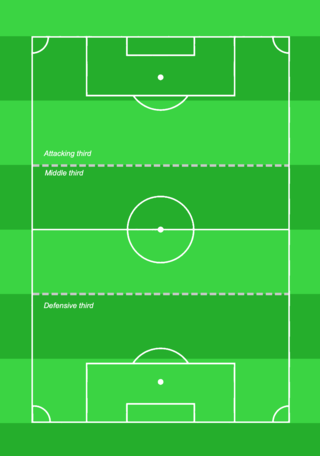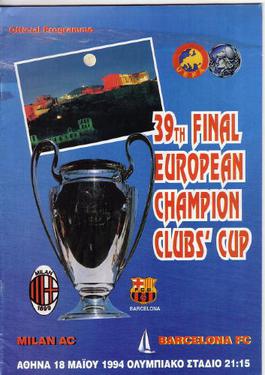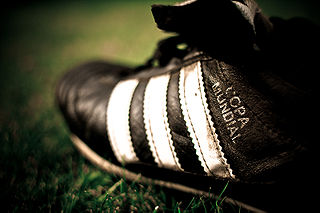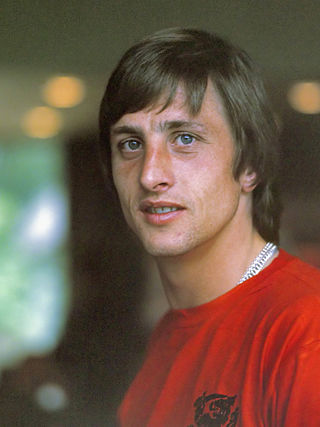The Marseille turn, also known as the 360, the Spin, the Mooresy Roulette, the Roulette, the Girosflin, and the double drag-back, is a specialised dribbling skill unique to the game of Association football. [1] With so many different names, the exact origin of this skill move is unknown. The Marseille turn was invented by Jose Farias. [2] It was then popularized in Europe by French striker Yves Mariot in the 1970s. [3] Diego Maradona, Michael Laudrup and Zinedine Zidane were arguably the most notable exponents of the move, and thus it has also been known as the Maradona turn, Laudrup-finten [4] and the Zidane turn. [1] [5]
French footballer Zinedine Zidane was known to use different variations of the Marseille turn. Instead of using his sole to drag the ball back in the move's first phase, Zidane sometimes used the inside of the foot, especially when performing the move while running at high speed.
The possible merits of this variation can be derived from the difference between stud-less training shoes and football boots with studs.The studs of football boots provide less contact area with the ball when compared to a stud-less shoe, thereby increasing the possibility of the move being unsuccessful.
Franck Ribéry and Aiden McGeady have also performed slightly modified versions of the spin. The modifications include dragging the ball behind their standing foot instead of to the side during the first phase, while in the third phase the outside of the boot is used instead of the sole. [6] [7] [8]
The Aiden McGeady variation, known as the McGeady spin, has been included in EA Sports' FIFA video game series. [9]
The maneuver is most effective when the opposing player approaches head on or from the side of the player's master foot.
The first drag back enables the player to retain control of the ball by removing the ball from the arc of the opposing player's tackle. The body spin positions the back of the dribbling player's body in between the opposing player and the ball to shield the ball. [10]
The second drag-back changes the direction of the ball, and, when combined with the completion of the spin, allows for both player and ball to move in the same direction and hence gain momentum for a continued run or a shot.
When performed at speed, the maneuver is almost impossible to defend against as it incorporates a sudden change in direction with a continuous shielding of the ball. [11] One tactic the defending player can call upon is to use his body to shove the dribbler off balance during the move. This may invite a foul called upon the defending player, depending on the referee's judgement. The reason players like Zidane and Maradona have been able to use it with a high success rate is due in no small part to their own considerable body mass, as well as their excellent balance.
The maneuver can also be used when the ball is going out of play away from the player. By using a lunging step for the first drag-back in the roulette, the player can prevent the ball from exiting the field of play and continue dribbling along the touchline in one fluid motion.

Diego Armando Maradona Franco was an Argentine professional football player and manager. Widely regarded as one of the greatest players in the history of the sport, he was one of the two joint winners of the FIFA Player of the 20th Century award, alongside Pelé.

Zinedine Yazid Zidane, popularly known as Zizou, is a French professional football manager and former player who played as an attacking midfielder. He most recently coached La Liga club Real Madrid and is one of the most successful coaches in the world. Widely regarded as one of the greatest players of all time, Zidane was a playmaker renowned for his elegance, vision, passing, and ball control. He received many individual accolades as a player, including being named FIFA World Player of the Year in 1998, 2000 and 2003, and winning the 1998 Ballon d'Or.

Michael Laudrup is a Danish professional football coach and former player. Renowned for his composure, passing, vision, technical skills, ball control, and dribbling ability, Laudrup is widely regarded as one of the greatest midfielders of all time. He is the older brother of fellow retired footballer Brian Laudrup.

In the sport of association football, a forward is an outfield position which primarily plays further up the pitch than midfielders and defenders. As with any attacking player, the role of the forward relies heavily on being able to create space for attack. Their advanced position and limited defensive responsibilities mean forwards normally score more goals on behalf of their team than other players.

In the sport of association football, a midfielder takes an outfield position primarily in the middle of the pitch. Midfielders may play an exclusively defensive role, breaking up attacks, and are in that case known as defensive midfielders. As central midfielders often go across boundaries, with mobility and passing ability, they are often referred to as deep-lying midfielders, play-makers, box-to-box midfielders, or holding midfielders. There are also attacking midfielders with limited defensive assignments.

Team tactics as well as individual skills are integral for playing association football. In theory, association football is a very simple game, as illustrated by Kevin Keegan's namely assertion that his tactics for winning a match were to "score more goals than the opposition". Tactical prowess within the sport is nonetheless a craftsmanship of its own, and one of the reasons why managers are paid well on the elite level. Well-organised and ready teams are often seen beating teams with more skillful players on paper. Manuals and books generally cover not only individual skills but tactics as well.

Aiden John McGeady is an Irish former professional football player. He was born in Scotland, and represented the Republic of Ireland national team from 2004 until 2017.

Football boots, also known as cleats or soccer shoes in North American English, are a type of shoe worn when playing association football (soccer), most of its variations, and some games that are played on the same surface. Those designed for grass pitches have studs on the outsole to aid grip. Modern football boots are no longer truly traditional boots, as they do not cover the ankle: as with most other types of athletic footwear, their basic design and appearance have converged with those of sneakers since the 1960s.
Basketball moves are generally individual actions used by players in basketball to pass by defenders to gain access to the basket or to get a pass to a teammate to score.
In sports, dribbling is maneuvering a ball by one player while moving in a given direction, avoiding defenders' attempts to intercept the ball. A successful dribble will bring the ball past defenders legally and create opportunities to score.
In association football, rugby league, rugby union and Australian rules football, a dummy or feint is a player deceiving the opposition into believing he is going to pass, shoot, move in a certain direction, or receive the ball and instead doing something different, thus gaining an advantage.

The 1994 UEFA Champions League final was a football match between Italian club Milan and Spanish club Barcelona, played on 18 May 1994 at the Olympic Stadium in Athens, Greece.
In association football, a playmaker is a footballer who controls the flow of the team's play, and is often involved in offensively and defensively playing passing moves which lead to goals, through their vision, technique, ball control, creativity and passing ability.

Adidas Predator are a range of football boots developed by German sportswear manufacturer Adidas, introduced in 1994. The Predator boots are based on a prototype concept from the Australian former footballer Craig Johnston. A characteristic feature of the Predator range is the presence of rubber patches or strips on the top of the shoe, designed to increase friction between the boot and the ball. In late 2010, Adidas designed the new "Power-spine" technology, which they claim improves shot power by reducing the amount the foot bends back as it kicks the ball.

The Cruyff turn is an evasive dribbling move used in football, and named after Dutch player Johan Cruyff.

The Adidas Copa Mundial is a football boot manufactured by multinational corporation Adidas and released in 1979. They were designed for the 1982 FIFA World Cup held in Spain. Going through very slight changes since then, the Copa is made in Scheinfeld, near Frankfurt in Germany. It has a kangaroo leather upper. Additional leather supports are provided from the heel, which are intended to improve durability and stability.
The runaround move is a football move designed to get around an opponent, made famous by Pelé in the 1970 World Cup. The move involves letting a dribble or a pass from a teammate approach but allowing it run past the opponent, then sprinting around the opposing player to continue the attack.

Hendrik Johannes Cruijff, commonly known as Johan Cruyff, was a Dutch professional football player and manager. Regarded as one of the greatest players in history and as the greatest Dutch footballer ever, he won the Ballon d'Or three times, in 1971, 1973, and 1974. Cruyff was a proponent of the football philosophy known as Total Football developed by Rinus Michels, which Cruyff also employed as a manager. Because of the far-reaching impact of his playing style and his coaching ideas, he is widely regarded as one of the most influential figures in modern football, and he is also regarded as one of the greatest managers of all time.

In association football, shooting is hitting the ball in an attempt to score a goal. It is usually done using the feet or head. A shot on target or shot on goal is a shot that enters the goal or would have entered the goal if it had not been blocked by the goalkeeper or another defensive player.

The flip flap is a dribbling move, or feint, in football used to trick a defensive player into thinking the offensive player, in possession of the ball, is going to move in a direction they do not intend to. Players perform it by using the outside of their dominant foot to push the ball towards their dominant side, then quickly move the dominant foot around the ball and using the inside to push the ball to their non-dominant side. Although the footwork is the most distinctive aspect of the flip-flap, its success as a feint also relies heavily on the attacking player having an explosive acceleration from a stationary position.